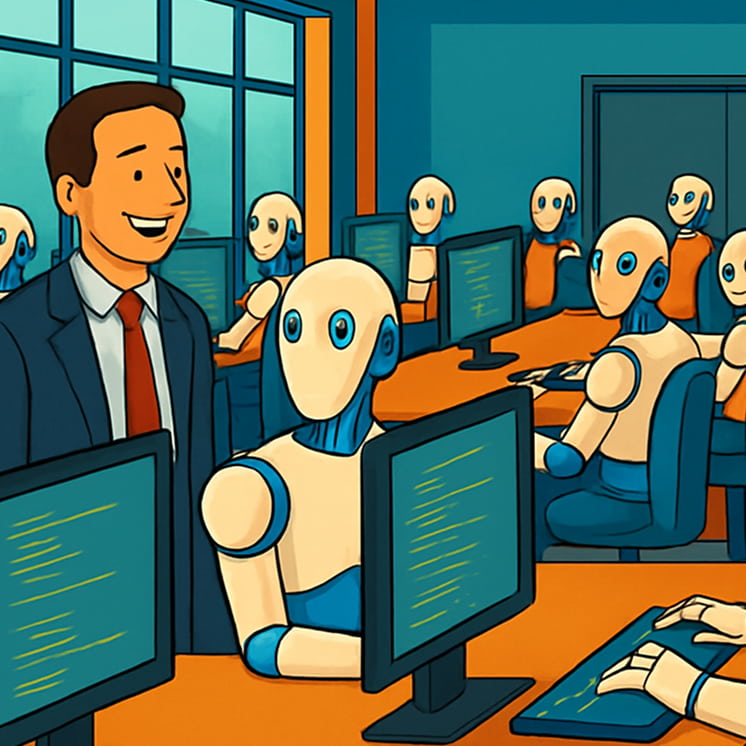Why AI gets the pilot - but product earns the renewal
• 6 minute read
By Chris Kindt, Head of Value Creation
"We're seeing fantastic engagement in pitches and pilots, but we're worried about what happens at renewal."
That comment from an AI scale up CEO last month captures a brewing problem in B2B software. Over 2 years into the generative AI wave, a pattern is emerging: while experimental revenues are flowing freely, the gap between AI demos and sustainable revenues remains.
The AI-native startups moved fast. They've landed pilots with impressive demos, and what we're calling 'ERR' - Experimental Recurring Revenue - has been flowing. But as many approach their first major renewal cycles, they are discovering that brilliant AI doesn't automatically translate to brilliant products.
Meanwhile, the products that are converting ERR into true ARR, building genuine customer dependency and sustainable revenues, share something fundamental: they aren't winning because of their AI. They're winning because they're brilliant products that happen to use AI.
The experimental revenue mirage
AI has driven extraordinary velocity in product development. Features that would have taken quarters to ship are now launching in weeks. The technology represents real progress, and the early market response has been enthusiastic.
But velocity without direction creates risks, especially where teams build from the AI capability outward rather than from the customer problem inward. The result is impressive demos that struggle to embed into actual customer workflows. AI features become something users try, rather than something they depend on.
What are B2B SaaS businesses doing where they are seeing strong renewal? They started with deep customer workflow analysis, identified genuine pain points, and only then determine whether AI provides the best solution. They obsess over integration with tools customers use daily: Microsoft Office, Salesforce, Netsuite.
This isn't to diminish the importance of AI - far from it. But the lesson from the first two years is clear: brilliant AI technology creates initial momentum, but brilliant product design creates lasting adoption.
The democratisation of AI capability
The early advantage from having access to leading AI models is compressing rapidly. When o1 launched, simply making use of state-of-the-art reasoning was differentiating. That window has closed.
The new generation of AI hyperscalers (OpenAI, Anthropic, AWS, Google) aren't just releasing models anymore. They're building complete platforms with agentic SDKs, workflow orchestration tools, and increasingly sophisticated developer frameworks. The capabilities continue to advance, but more importantly, they're becoming dramatically easier to access and implement.
AI models are no longer a moat – they’re the new baseline. Every B2B SaaS company can now integrate leading AI capabilities. The real question becomes: what do you do with that access?
When everyone has access to the same capabilities, differentiation shifts back to fundamentals. Deep domain expertise that no LLM can replicate. Years of understanding customer pain points and how they manifest across different segments. The upstream and downstream integrations that make you indispensable to daily operations. The subtle workflow optimisations that come from watching thousands of customers use your product.
This is the fractal complexity of vertical markets, the nuanced domain knowledge, the trust relationships, the understood context. AI labs developing foundation models aren't focused on the intricacies of legal practice management or construction project workflows. That domain depth remains the province of vertical specialists.
What brilliant products actually require
If model access is table stakes, what separates products that sustain adoption from those that don't?
The answer is more prosaic than the hype suggests. Brilliant products demand far more than a bleeding-edge frontier LLM. They require what we might call 'thick context engineering': thousands of lines of code and prompts, that combine model calls with robust data handling, authentication, workflow orchestration, and reliable SaaS infrastructure.
Context engineering handles the messy realities of business operations: incomplete data, ambiguous inputs, edge cases that represent 30% of actual usage rather than the 5% assumed in the demo. They need smart, deterministic 'plumbing' for the workflows where AI isn't the answer, or where a rules-based approach is more reliable and cost-effective.
And they still require a human support layer. Not because the AI fails completely, but because the last 5% of edge cases matter enormously to customer trust. When something breaks or behaves unexpectedly, customers need to know there's someone who can step in and resolve it.
This is the unglamorous reality of product development that the AI narrative often glosses over. The boring infrastructure work. The integration testing. The performance optimisation. The customer support escalation paths. These aren't optional extras - they're the difference between a compelling demo and a product customers can't live without.
The incumbent advantage - if mobilised
This shift in what matters should favour incumbent B2B SaaS businesses. You already have the domain expertise. You understand the customer workflows intimately. You have established trust relationships and existing integrations. You generate the data that could power more sophisticated AI applications.
But advantage only matters if it's mobilised.
The challenge isn't whether to build AI products - that question has been settled. The challenge is accelerating how product innovation happens: new types of products, built at new speeds, without losing the product discipline that created your current market position.
This means confronting new organisational bottlenecks. AI product development requires different skills in R&D and creates new pressure points in SaaS infrastructure not designed for AI workload patterns. Success metrics cannot end at pilot sign-ups but extend to usage intensity.
The teams we're seeing pull ahead share common patterns. They treat AI as a tool in service of customer outcomes. They invest as heavily in reliability, integration depth, and performance as in AI capabilities. They measure success by renewal rates and usage intensity, not pilot sign-ups.
Building the product innovation engine
This imperative for accelerated product innovation is precisely why we built Hg Catalyst - a product innovation engine designed to work alongside portfolio companies.
Catalyst brings together AI engineers, product managers, and designers who understand that the breakthrough happens where technical possibility meets customer practicality. Working embedded within portfolio teams, we've helped launch +10 AI-powered products now generating meaningful ARR across multiple businesses. Some have already added significant (+40%) new logo bookings in year 1 - not from experiments or pilots, but from products that have become essential to customer workflows.
What we're learning compounds across the portfolio. One company's breakthrough in workflow integration becomes pattern we can apply elsewhere. Challenges in context engineering get solved once and shared across multiple implementations. The collective intelligence grows with each build.
The results validate the approach: when you start with the customer problem, layer in AI thoughtfully, and wrap it in robust SaaS infrastructure, sustainable adoption follows. ERR converts to ARR because customers genuinely can't imagine working without it.
The renewal test ahead
As one Venture investor put it, "The next twelve months will separate AI tourism from AI transformation."
When those experimental licences come up for renewal, customers will ask one question: "Can I live without this?" For products built primarily to showcase AI capabilities, the answer may be uncomfortable. For products that solved genuine workflow problems and happened to use AI to do so, the answer will be obvious.
The real battleground isn't AI technology - it's building brilliant products that customers depend on. AI has raised the stakes and accelerated the pace, but it hasn't changed what fundamentally matters: deep domain expertise, intimate customer understanding, and disciplined product execution.
For incumbent B2B SaaS businesses, this should be encouraging. The capabilities that built your market position remain essential - they just need to be deployed with new urgency and new tools. The race isn't to become an AI company. It's to remain a brilliant product company in an AI-enabled world.
Ready to accelerate your product innovation in the AI era?
We're expanding Catalyst across Europe and North America, bringing together product leaders, AI engineers, and domain experts who understand that customer obsession, not AI obsession, wins markets. Get in touch at hgcatalyst.com or contact joincatalyst@hgcapital.com
Related Articles


